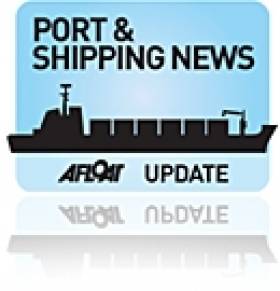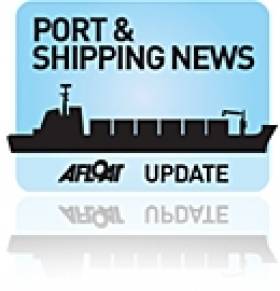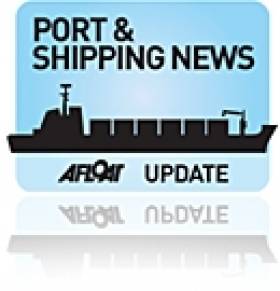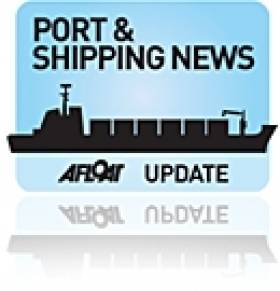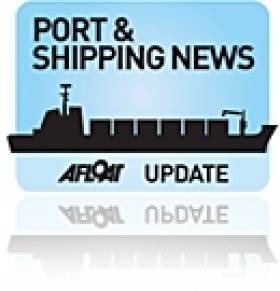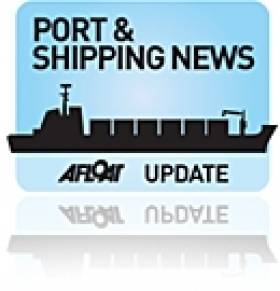Displaying items by tag: IMDO Shipping Review
IMDO Shipping Review: Irish Exports Down, Diversifying Cargo Shift, Container Rates Increase and more
#Ports&Shipping –The latest IMDO Weekly Shipping Market Review includes the following stories as detailed below.
Irish Economy: Exports down in Q3 - The Irish Exporters Association's latest quarterly review has indicated that merchandise exports fell in quarter 3 by 8.6% year-on-year, with total exports down 1.3% y-o-y. Underlying the overall decline, manufacturing exports were particularly weak, falling 7.8% y-o-y, while the services sector and agri-food proved the main export drivers, growing at 6.5% and 7.1% respectively.
Roll-On Roll-Off: Diversifying Cargoes - A shift has been noticed in RoRo markets as deep-sea car carriers look to attract not only vehicles but additional types of traffic such as construction equipment and project cargo. Japanese operator K Line recently ordered four new car carriers to replace existing tonnage, each with 7,500-unit capacity and "the widest beam ever built" enabling them to better accommodate a variety of RoRo cargoes.
Container: General Rate Increase - A general rate increase (GRI) for spot container rates came into force on 1 November causing the overall Shanghai Containerised Freight Index (SCFI) to jump 26.5%, with far larger increases on specific routes. The success of this GRI is largely due to the discipline of the carriers, which did not occur last time in September according to HSH Nordbank.
For more on each of the above and other stories click the downloadable PDF IMDO Weekly Markets Review (Week 44). In addition to Afloat.ie dedicated Ports & Shipping News section.
IMDO Shipping Review – Irish Tourism Up, P3 Capacity Long-Haul Changes, EU Passes Ship Recycling and more
#Ports&Shipping –The latest IMDO Weekly Shipping Market Review includes the following stories as detailed below.
Irish Economy: Boost to Irish tourist numbers - The Irish economy has received a welcome boost as the number of trips by overseas residents increased by 7.8% between July and September compared to the same period last year. According to the Central Statistics Office, the figures which include tourists and people on business trips, increased by 164,300 trips in comparison to quarter three 2012 bringing the total to just over 2.2 million trips.
Container: P3 capacity on front-haul routes not set to change - Asia-Europe, Transatlantic and Transpacific capacity on the proposed P3 network will remain largely unchanged from the current service offers by Maersk, MSC & CMA CGM, according to Lloyd's List.
Based on analysis by Alphaliner, it is expected that while the frequency of most services will be marginally reduced, the deployment of lager -capacity vessels will result in average weekly TEU shipped on the three front-haul routes remaining the same.
Regulation: Ship recycling regulation passes EU Parliament -The European Parliament backed plans last week to end scrapping of EU-registered ships on third-country beaches, according to Fairplay. This measure will ensure vessels are recycled in EU-approved facilities worldwide, as opposed to the highly polluting practice of beaching.
For more on each of the above and other stories click the downloadable PDF IMDO Weekly Markets Review (Week 43). In addition to Afloat.ie dedicated Ports & Shipping News section.
IMDO Shipping Review: Irish Trade Surplus Increase, Piracy 7-Year Low, Container P3 Price Rise and more
#Ports&Shipping –The latest IMDO Weekly Shipping Market Review includes the following stories as detailed below.
Irish Economy: Trade surplus increases - Preliminary figures released by the Central Statistics Office last week show that Ireland's seasonally adjusted trade surplus rose 1% to €3.2bn in August as exports increased to €7.6bn (+4%) and imports increased to €4.4bn (+7%). Despite these increases, in comparison to last year, the value of exports has decreased by 17% to €6.96bn, with particular declines in organic chemicals and pharmaceuticals.
Piracy: Attacks at 7-year low- Worldwide piracy incidents have fallen to their lowest year-to-date level since 2006, according to the International Maritime Bureau's latest piracy. The report records 188 piracy incidents for the first nine months of 2013, down from 233 for the same period in 2012, a drop of 19.3%. Hostage-taking has also fallen sharply, down 41.5% with 266 hostages taken this year as against 458 in the first three quarters of 2012.
Container:P3 may increase price competition and volatility- Investigation into the P3 alliance of Maersk Line, MSC and CMA CGM has concluded the alliance has the potential to increase rate volatility and induce higher price competition between carriers. Maritime consultants Alphaliner have highlighted that the P3 is only an operational alliance and that commercial competition remains.
For more on each of the above and other stories click the downloadable PDF IMDO Weekly Markets Review (Week 42). In addition to Afloat.ie dedicated Ports & Shipping News section.
IMDO Shipping Review: ESPO Launch PORTOPIA, Container Cascading, VLCC Demolitions and more
#Ports&Shipping –The latest IMDO Weekly Shipping Market Review includes the following stories as detailed below.
Ports: Europe to benchmark ports - The European Sea Ports Organization (ESPO) last week confirmed the launch of the PORTOPIA (Ports Observatory for Performance Indicators Analysis) project –the largest European research project on ports since the 1996 European Port Policy was launched.
Container: Cascading threatens North-South services - Excess capacity on main trade lanes threatens to depress freight levels on North-South container services if carriers continue cascading excess tonnage, according to Drewry's Container Freight Rate Insight. In the year -to-date, 25 vessels of more than 10,000 teu have been delivered on the main East-West routes, with the pressure-release being provided by shifting excess tonnage onto North-South routes –mainly Asia to South Africa, Australia and the East and West coasts of South America.
Tanker: Rates rally on demolition news - The onset of the largest demolition program in a decade will see a rallying of rates in the tanker market, according to E.A. Gibson Shipbrokers. Twenty-three very large crude carriers (VLCCs) are set to be demolished in the current calendar year, with similar scrappings expected up to 2016. Presently, rates are at a record low; figures from Clarkson's show average earnings this year for VLCCs hauling 2mn barrels of crude oil are at their lowest since records began in 1997.
For more of the above and other stories click the downloadable PDF IMDO Weekly Markets Review (Week 41). In addition to Afloat.ie's dedicated Ports & Shipping News section.
IMDO Shipping Review: Irish Trade Surplus, LNG Port Alliance, Bulker Tonnage Oversupply and much more
#Ports&Shipping –The latest IMDO Weekly Shipping Market Review includes the following stories as detailed below.
Irish Economy: Trade Figures - The seasonally adjusted trade surplus rose to €1 billion in August as exports increased in the month, new data from the CSO showed last week. The figures indicated that exports rose by €1.26 billion, an increase of 16 per cent compared with July, to €9.1 billion. Imports, meanwhile, were €215 million higher, up 5 per cent on the previous month at almost €4.2 billion. That left the surplus at €4.92 billion for August.
LNG: Port Alliance - The largest Port in Europe, the Port of Rotterdam, and the largest Port in Scandinavia, the Port of Gothenburg, has entered in to a new alliance as noted by World Maritime News. The aim is to speed up the establishment of liquefied natural gas as a maritime fuel. A memorandum of understanding will be signed between the Port of Rotterdam and the Port of Gothenburg.
Dry Bulk Market: Tonnage oversupply - Mark Williams, Research Manager at Braemar Seascope Ltd. , has stated shipping markets are expected to keep facing issues of tonnage oversupply, despite demolition activity reaching record-breaking levels, which will continue to exert pressure on freight rates, over the coming months, as noted by Hellenic Shipping.
For more on each of the above and other stories click the downloadable PDF IMDO Weekly Markets Review (Week 41). In addition to coverage on Afloat.ie's dedicated Ports & Shipping News section.
IMDO Shipping Review: Irish Manufacturing Growth,Panamax Market Overcapacity, New Shipping Bank and more
#Ports&Shipping –The latest IMDO Weekly Shipping Market Review includes the following stories as detailed below.
Irish Economy: Manufacturing Improves - The Irish manufacturing sector showed continued growth in September, with the release of the Investec Manufacturing Purchasing Managers Index (PMI) highlighting a 14-month high figure of 52.7 points, up from 52.0 in August. New orders, down 0.1 points from a 13-month high of 53.6 in August, recorded continued growth in both domestic andexport markets, leading to the rise in overall production during the month.
Container Market: Panamax Vessels Threatened by Cascading - The Panamax container market may experience overcapacity according to Lloyd's List if other carriers follow Maersk's lead to replace chartered tonnage after cascading its Triple-E 18,270 TEU capacity vessels. Cascading is the process of moving larger vessels from main trade routes onto smaller trade routes as they are displaced from the main trade routes by the entrance of even larger ships.
Finance: Dedicated Shipping Bank - Solace for second-tier shipowners has arrived as a group of shipping executives have launched the Maritime and Merchant Bank in Oslo, claiming the industry needs a financial institution to fill the void created by the main banks and lenders leaving the shipping market, due to the economic squeeze and new Basel III capital requirements. The bank has targeted capitalization of about $300m through an IPO next year.
For more on each of the above and other stories click the downloadable PDF IMDO Weekly Markets Review (Week 40). In addition to Afloat.ie's dedicated Ports & Shipping News section.
IMDO Shipping Review: Economy Top-Tier, Container Orders Rise, Tanker Instability and much more
#Ports&Shipping –The latest IMDO Weekly Shipping Market Review includes the following stories as detailed below.
Irish Economy: Top tier ranking in EU competitiveness table - The Irish economy recorded a strong performance in the 2013 EU Competitiveness report, released this past week, scoring particularly well in all areas of industrial competitiveness. Notable strengths included figures showing Ireland to have the second most attractive business environment in the EU and the highest percentage of highly skilled employees in manufacturing, at almost 40%
Container Market: Increasing Orderbook - Box ship orders for the first eight months of 2013 have totalled 1.34Mteu, a 205% increase on the same period last year, according to Fairplay. Raymond Yap, CIMB Securities shipping analyst, stated this could lead to a full year total which exceeds the 1.8Mteu ordered in 2011, which was the highest since the 2008/09 financial crisis.
Tanker Market: Middle East crises further compounds overcapacity - Instability in the Middle East is adding further to the woes of the struggling Tanker segment, RS Platou's head of research told Fairplay.Ole-Rikard Hammer compared the effects of the current crises in Syria, Libya and Egypt to those of the Gulf War in the early 1990's, suggesting that tanker owners should beprepared for a difficult long term outlook.
For more on each of the above and other stories click the downloadable PDF IMDO Weekly Markets Review (Week 39). In addition to Afloat.ie's dedicated Ports & Shipping News section.
IMDO Shipping Review: Ireland Exits Recession, End to Container Rates Rise, Newbuilding Unseasonal Boost and much more
#Ports&Shipping –The latest IMDO Weekly Shipping Market Review includes the following stories as detailed below.
Irish Economy: Ireland exits recession - The Irish economy has growth once again, according to data from the CSO.
The economy grew by 0.4%in the second quarter of the year, although this was weaker than the 0.8% that many economists had forecast. In the first quarter, GDP fell by 0.6%. The growth in GDP was largely fuelled by a rise in exports and consumer spending.
Container Market: End to rate rises- Container rates rose for the second consecutive month in August, but a report from Drewry last week warned that it will not continue.
Drewry predict that the situation is likely to reverse towards the end of the year due to renewed weakness in trades from Asia. "Pricing on Asia origin trades has been buoyed by peak season volumes, but as the
trade enters the shoulder season still plagued by overcapacity, rates will come under renewed pressure,"Drewry predicted.
Newbuilding: Unseasonal August - August was an uncharacteristically good month for ship-buildersas many ship-owners took advantage of favourable pricing to invest heavily.
According to the latest report from shipbroker Golden Destiny, August ended with upward momentum in the second-hand and newbuild markets, while demolition activity declined.
For more on each of the above and other stories click the downloadable PDF IMDO Weekly Markets Review (Week 38). In addition to coverage on Afloat.ie's dedicated Ports & Shipping News section.
IMDO Shipping Review: Trade Surplus Increase, ShortSea No Profit to 2020, Old VLCC Values Rise and more
#Ports&Shipping –The latest IMDO Weekly Shipping Market Review includes the following stories as detailed below.
Irish Economy: Growing trade surplus - Trade figures published by the CSO, indicate that the seasonally adjusted value of Irish exports increased by 3% in July, to just over €7.33bn.This, together with a 2% drop in the value of imports to €4.12bn meant that Ireland's seasonally-adjusted trade surplus grew by 8% to €3.21bn.The surplus had been gradually declining over the previous three months, having gone from €3.6bn in March to €2.96bn in June.
Short Sea Market: No profitability till 2020 - Europe's shortsea operators are predicted by Dutch consultancy Bloem Doze Nienhuis to have another six years of struggle before returning to profitability.
Their report suggests that supply and demand for shortsea remains unbalanced, with profitability not returning until 2020. The study of the main operators shows a cargo demand of around 1.8bn tonnes between 2005 and 2012, with the shortsea fleet increasing by 20% to 47m dwt. In 2012 and the first half of 2013 freight rates reached new all-time lows.
Tanker Market: Old VLCC values rise -The incentive to scrap older VLCCs has decreased after Japan'sNYK line sold a 14-year-old 281,050dwt VLCCfor $21m, a large increase on its current scrap value.By contrast, in late July,OSX Leasing Groupsent a 1995-built, 301,862dwt tanker to Pakistani shipbreakers for $16.6m.
For more on each of the above and other stories click the downloadable PDF IMDO Weekly Markets Review (Week 37). In addition to Afloat.ie's dedicated Ports & Shipping News section.
IMDO Shipping Review: Irish Service Sector Growth, Capesize Rates High, Potential Eco-Ships Savings and much more
#Ports&Shipping –The latest IMDO Weekly Shipping Market Review includes the following stories as detailed below.
Irish Economy: Service sector growth - Fine summer weather, rising tourist numbers and continued signs of a growth saw Ireland's service sector grow at its fastest rate in 6 years in August.
The Investec Purchasing Managers' Index (PMI) measured services sector activity rise from 57.6 in July to 61.6 in August, the highest reading since February 2007 and well above the crucial 50 mark, which denotes that the activity level is expanding.
Bulker Market: Capesize Rates Hit High - The rates for the Capesize market have hit a year high of $19,811 as the Baltic Capesize Index surged 215 points to close at 2,660 last week. Backed by strong iron ore shipments from Brazil, Australia and South Africa into China, daily Capesize rates have risen by $1,957 since 4 September.
Container Market: Potential Savings of EcoShips - Eco designs for container ships could be the cost-saving future and make or break operators. A Hamburg conference has been told that a fuel-efficient design for a 9,000 TEU containership could save $2m a year, enabling it to reduce slot costs.
For more on each of the above and other stories click the downloadable PDF IMDO Weekly Markets Review (Week 36). In addition to Afloat.ie's dedicated Ports & Shipping News section.


























